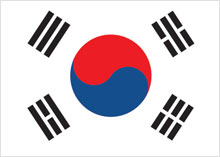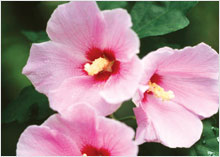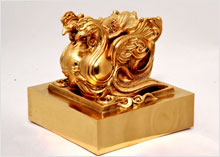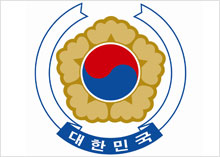SYMBOLS
The National Flag - Taegeukgi

Korea's national flag, Taegeukgi, consists of a taegeuk circle in the center and four trigrams - geon (heaven), gon (earth), gam (water), and ri (fire) - in each of the four corners, set against a white background.
The white background symbolizes brightness and purity and reflects Koreans peace-loving national trait. The taegeuk circle at the center symbolizes the harmony of yin (blue) and yang (red). It represents the concept that everything in the universe is created and developed through the interaction of yin and yang.
The four trigrams surrounding the taegeuk circle denote the process of yin and yang undergoing a spiral of change and growth, and are named geon, gon, gam, and ri.
These four trigrams, in combination with the taegeuk circle at the center, produce a harmonious, unified appearance.
As such, Taegeukgi, centered on the taegeuk design favored by the ancestors of Korea, embodies the ideals of the Korean people, who have long pursued creation and prosperity as universal principles.
The National Anthem - Aegukga
Aegukga means "the song of love for the country," and is recited as the Republic of Korea's national anthem.
It was during the enlightenment period of the late Joseon Dynasty (A.D. 1392~1910) when different songs and lyrics were sung under the name Aegukga. The Dongnip Sinmun (Independence News), founded in 1896, published several versions of lyrics for Aegukga. It is not clear, however, what tune they were sung to. Records show that a Western-style military band was formed during the Great Korean Empire and that Daehan Empire Aegukga was played at important national events in 1902.
The original lyrics of Aegukga appear to have been written around 1907 to boost patriotism and cultivate a spirit of independence as the nation faced threats from foreign aggressors. Over the years, different national leaders have revised the words until they evolved into what we sing today. During the evolution of Aegukga, however, it continued to be sung to the tune of the Scottish folk song, Auld Lang Syne.
An Ik-tae, a Korean composer who was active overseas at the time, thought it regrettable that Aegukga should be sung to the tune of another country's song. In 1935, he composed a new tune, which the Provisional Government soon adopted. While Koreans outside the country sang the anthem to the new tune, those at home continued to use Auld Lang Syne until after liberation in 1945.
After the founding of the Republic of Korea in 1948, Aegukga started to be sung to the new tune at all government functions. It quickly spread nationwide and was published in several textbooks. Aegukga was also disseminated abroad widely, firmly taking root as the country's national anthem.
The National Flower - Mugunghwa(Rose of Sharon)

Koreans have admired the rose of Sharon as a heavenly flower since ancient times, so much so that the Silla Kingdom (57 B.C.~A.D. 935) called itself "Mugunghwa Country." The ancient Chinese, too, referred to Korea as the "land of gentlemen where the mugunghwa blooms." Affection for the flower was further heightened when the words "Mugunghwa samcheonli hwaryeogangsan (Three thousand ri of splendid rivers and mountains, filled with roses of Sharon)" were included in the national anthem in the late 19th century.
(Note: a ri is a traditional Chinese unit of length equal to 393 meters; in Aegukga, 3,000 ri is equivalent to 1,200km, the length of the Korean Peninsula.)
Because the rose of Sharon has been an important symbol of Korean culture for centuries, it was only natural for the government to adopt it as the national flower after Korea was liberated from Japanese colonial rule.
Koreans cherish the national flower because it honors Korea's noble spirit and symbolizes the many successes as well as tribulations that the nation has experienced.
Mugunghwa are divided into three types based on color: dansim (white, red, purple, and blue varieties), baedal, and asadal.
Dansim : Flower with a red center
Baedal : Pure white flower with no coloring in the center
Asadal : Flower with a red center and pink spots on the petals' edges
From early July to mid-October, the rose of Sharon blooms daily, and some 2,000 to 3,000 flowers can bloom on a single plant. It survives and grows well even when transplanted or cut for planting, and resists pollution well. As such, the flower symbolizes the diligence and perseverance of the Korean people.
The National Seal - Guksae

A national seal is an official seal used in national affairs and stamped on important national documents as the nation's symbol. It symbolizes national authority and reflects a nation's power, culture, and characteristics of an era. A national seal generally takes the form of an engraved imprint in Eastern countries and an embossed imprint in the West.
The Korean government stamps Guksae on significant national documents such as the promulgation decree of the Constitution, certificates of national decoration, appointment certificates for government officials appointed by the President, diplomatic credentials, and important diplomatic papers.
The National Emblem - Nara Munjang

Emblems have been used mostly in western countries to symbolize the genealogical records and authority of states, organizations, and families. Korea's national emblem is designed in the shape of a mugunghwa, also known as the rose of Sharon, which encircles the taegeuk motif. It is used on such items as important government documents issued to foreign institutions, decorations, Presidential commendations, and diplomatic missions abroad.



 INTERNATIONAL
INTERNATIONAL